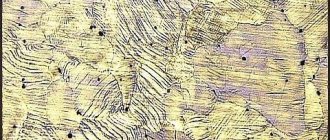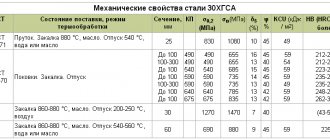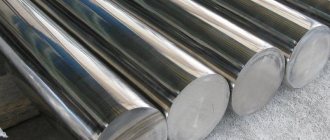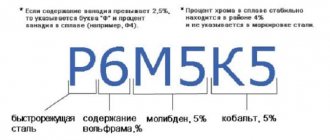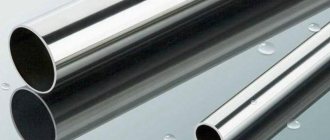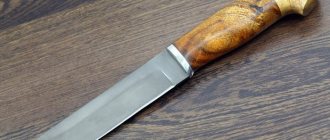St3ps steel is a semi-quiet version of the legendary steel 3 or st3Gsp (read about it in the materials on our website). This alloy is commonly used in construction work, mechanical engineering, gas and water supply systems, and the production of fencing and decorative steel products. Widely used for making minor steel structures. St3ps steel is indispensable for solving simple problems that require inexpensive, high-quality and practical metal with positive machinability characteristics. Among other popular alloys, it is easy to find on the streets of any city. The main advantage of st3ps steel is its versatility and price.
Decoding
The interpretation of steel st3ps is given in GOST 380-2005. According to the document:
- st indicates that the steel belongs to alloys of ordinary quality. Depending on the sulfur and phosphorus content, steels are of ordinary quality, high-quality, high-quality and especially high-quality. For steel st3ps and other steels of this class, the sulfur content cannot exceed 0.06%, phosphorus 0.07%.
- 3 serial number of the grade according to GOST 380-2005 means that the steel corresponds to the chemical composition specified in the document for grade 3.
- ps - means that the degree of deoxidation of the steel is semi-quiet. Deoxidation is the process of removing oxygen and nitrogen gases. There are three categories of steel according to the degree of deoxidation: calm (sp), semi-quiet (ps), boiling (kp). The less gases are released during the solidification of the alloy, the fewer pores and bubbles in the metal structure, the higher the strength.
Technological qualities
This steel is not prone to such defects as temper brittleness. Non-floc sensitivity is also observed, and weldability is practically unlimited. Further, it is important to note that all structural materials are divided into groups depending on corrosion resistance, quality of mechanical properties and degree of weldability. If we talk about mechanical characteristics, then rolled steel is divided into three groups - regular, increased and high strength.
The basic properties of raw materials depend on its chemical components. Ferrite is the main structural material. This material itself is considered low-strength, but ductile. Such properties of the base substance do not allow the use of ferrite in its pure form, since its use, for example, for building structures is prohibited. It is in order to improve the strength characteristics that the composition undergoes a process of carbon saturation. Regular group steels are low-carbon materials; the middle group includes substances that are alloyed with chemical additives such as chromium, nickel, silicon, and manganese. High-strength substances are additionally alloyed using thermal hardening.
Chemical composition
St2ps steel is 98% iron. The remaining 2% includes carbon, manganese, nickel, chromium, silicon, copper, sulfur, phosphorus, arsenic, scandium, nitrogen, aluminum. The table below shows the exact content of the most significant elements. Minor impurities do not seriously affect the characteristics of the metal and are therefore not taken into account.
The most important alloy elements, besides iron, are:
- carbon high carbon content provides steel with hardness, strength and elasticity;
- manganese in the composition is responsible for deoxidation and removal of sulfur, and also makes steel stronger;
- silicon deoxidizer, which forms a fine-grained structure of steel, improves technological properties, strength, and does not reduce ductility.
Harmful impurities are sulfur and phosphorus; the lower their concentration in the alloy, the higher quality the steel is considered.
Chemical composition, % (GOST 380-94)
| C carbon | Mn manganese | Si silicon | P phosphorus | S sulfur | Cr chrome | Ni nickel | Cu copper | As arsenic |
| no more | ||||||||
| 0,14-0,22 | 0,40-0,65 | 0,05-0,17 | 0,04 | 0,05 | 0,30 | 0,30 | 0,30 | 0,08 |
Production nuances
The characteristics of a metal are determined based on its chemical composition and manufacturing technology. The basis of ST3PS steel is ferrite - a solid solution of carbon, nickel and chromium. The more carbon a material contains, the higher its strength.
Undesirable impurities in the composition are sulfur (0.05%) and phosphorus (0.04%). Sulfur forms sulfur grains, which causes red brittleness in steel. Phosphorus interacts with ferrite, which reduces ductility when working at elevated temperatures and increases cold brittleness in the cold.
For the production of ST3PS steel, open-hearth and converter production methods are used. The basic characteristics of the metal are identical for any method, but the converter method has a lower cost.
Return to content
Application
St3ps steel is a carbon structural steel of ordinary quality; it is a general purpose steel. It is used at normal temperatures, and is used to make welded and non-welded structures in construction and mechanical engineering. The properties of steel allow it to be used in load-bearing structures and loaded elements, such as load-bearing trusses, beams, channels, rails, etc. Steel is not alloyed and is not protected from corrosion in direct contact with water, and is also vulnerable in alkaline and acidic environments. A thick layer of galvanic coating or paint is required for protection.
Standardized indicators of St3ps steel by rolled category (GOST 535-2005)
| Category | Chemical composition | Temporary resistance σв | Yield strength σt | Relative elongation δ5 | Cold bending | Impact strength | ||||
| KCU | KCV | |||||||||
| At temperature, °C | After mechanical aging | At temperature, °C | ||||||||
| + 20 | -20 | + 20 | -20 | |||||||
| 1 | — | + | + | + | + | — | — | — | — | — |
| 2 | + | + | + | + | + | — | — | — | — | — |
| 3 | + | + | + | + | + | + | — | — | — | — |
| 4 | + | + | + | + | + | — | + | — | — | — |
| 5 | + | + | + | + | + | — | + | + | — | — |
| 6 | + | + | + | + | + | — | — | — | + | — |
| 7 | + | + | + | + | + | — | — | — | — | + |
NOTE
- The “+” sign means that the indicator is normalized, the “-” sign means that the indicator is not normalized.
- The chemical composition of steel according to heat analysis or in finished rolled products is in accordance with the order.
Parameters for the use of electric-welded straight-seam pipes made of St3ps steel (GOST 32569-2013)
| Steel grade, strength class, standard or specifications | StZps4 GOST 380 | ||
| Technical requirements for pipes (standard or specifications) | GOST 10706 group B | ||
| Nominal diameter, mm | 400-1400 | ||
| Types of tests and requirements (standard or specifications) | GOST 10706 | ||
| Transported medium (see designations in table 5.1) | Group B media, except LPG | ||
| Pipeline design parameters | Maximum pressure, MPa | ≤1,6 | |
| Maximum temperature, °C | 200 | ||
| Pipe wall thickness, mm | — | ||
| Minimum temperature depending on the pipe wall thickness with stress in the wall from internal pressure [σ], °C | more than 0.35[σ] | minus 20 | |
| no more than 0.35[σ] | minus 40 | ||
- NOTE. Groups of media, see table 5.1 GOST 32569-2013
Parameters for the use of electric-welded spiral-welded pipes made of St3ps steel (GOST 32569-2013)
| Steel grade, strength class, standard or specifications | StZps2 GOST 380 | ||
| Technical requirements for pipes (standard or specifications) | TU 14-3-954-80 | ||
| Nominal diameter, mm | 500-1400 | ||
| Types of tests and requirements (standard or specifications) | TU 14-3-954-80 taking into account the requirements of clause 2.2.10 GOST 32569-2013 | ||
| Transported medium (see designations in table 5.1) | All media except group A and LPG | ||
| Pipeline design parameters | Maximum pressure, MPa | ≤2,5 | |
| Maximum temperature, °C | 300 | ||
| Pipe wall thickness, mm | ≤12 | ||
| Minimum temperature depending on the pipe wall thickness with stress in the wall from internal pressure [σ], °C | more than 0.35[σ] | minus 20 | |
| no more than 0.35[σ] | minus 20 | ||
Conditions for using St3ps steel for bodies, covers, flanges, membranes and valve assembly made from rolled products, forgings (stampings) (GOST 33260-2015)
| Material | ND for supply | Temperature of the working medium (wall), °C | Additional instructions for use |
| St3ps GOST 380 | Forgings GOST 8479 Long products GOST 535, categories 3-5 | -30 to 300 | For welded fittings for pressure PN≤2.5 MPa (25 kgf/cm2) |
| Sheet GOST 14637, categories 3-6 | -20 to 300 | For welded fittings for pressure PN 5 MPa (50 kgf/cm2). For categories 4, 5, sheet thickness for St3ps is no more than 25 mm; for category 3 sheet thickness no more than 40 mm |
Steel St3sp: characteristics, chemical composition and properties
Welding steel St3sp
St3sp is characterized by unique weldability, which provides a wide range of technical characteristics that can be improved with the help of alloying additives.
The properties of steel make it possible to use arc welding - automatic and manual, welding using contact spot and electroslag technology. It is important for all welding work that steel of this grade can be easily welded without preparatory measures - special preparation, and the products do not require processing after welding. Although this only applies to welding products with a thickness of less than 3.6 cm. It is recommended to preheat steel products with greater thickness (100 ° C) and perform heat treatment after welding.
To weld products made from St3sp, it is advisable to use wire electrodes (most often with a large cross-section) with melting nozzles.
Delivery form of steel St3sp
This steel is supplied in various forms - forgings and castings, section steel - sheets, square and round pipes, shaped rolled products (I-beams, T-bars, channels, angles), ingots, slabs and blooms, sutunki, blanks, hardware, wire, strips, stampings etc.
Application area
Manufacturing of elements of load-bearing structures, welded and non-welded parts and products operated under positive temperature conditions. As well as sheet and shaped rolled products, the operation of which is carried out at temperatures of -40°C - +425°C, and/or loads with variable values (static, dynamic).
Application of St3sp steel, taking into account characteristics and properties
This type of steel is one of the most popular in construction and industry.
The absence of oxygen in the alloy and a homogeneous structure are factors that increase resistance to corrosion in aggressive environments. These qualities, as well as high ductility, make this steel indispensable in the production of structures and elements that have high rigidity requirements.
These are rolled products - sheet and shaped (channels, I-beams and T-beams, angles), blanks for fittings, pipeline elements (in particular, square pipes), etc.
The characteristics of steel make it possible to construct supporting load-bearing structures and frames from it, the operation of which is carried out in difficult conditions.
Elements and parts are made from St3sp steel without heat treatment, which makes it possible to preserve all the characteristics of the alloy - flanges, tees, transitions.
Steel is also used as a base layer in the production of hot-rolled 2-layer sheets that are resistant to corrosion.
Analogs St3sp
Brand st3sp (analogs - S255, VSt3sp5-1 and 18sp, E 235-C according to ISO 630:1995)
Assortment
- Channels are parallel (P), with sloped flanges (U), equal-flange bent;
- round sections circle and reinforcement;
- VGP pipes, electric welded (ES), seamless (BGD), nominal diameter 10, 15, 20, 25, 32, 40, 50, 65, 80, 90, 100 mm;
- I-beams, wide-flange, column, special, with flange slopes;
- steel square;
- steel wire rod;
- corners equal and unequal;
- square and rectangular profile;
- sheet steel: hot-rolled, corrugated, expanded metal, strip.
Type of delivery
| B03 - Metal forming. Forgings | GOST 8479-70; |
| B20 - Classification, nomenclature and general standards | GOST 380-2005; |
| B22 – Long and shaped rolled products | GOST 5267.0-90; GOST 5781-82; GOST 8239-89; GOST 8240-97; GOST 8510-86; GOST 8509-93; GOST 10884-94; GOST 30136-95; GOST 9234-74; GOST 4781-85; GOST 10551-75; GOST 25577-83; GOST 5422-73; GOST 535-2005; GOST 19240-73; GOST 19425-74; GOST 2590-2006; GOST 11474-76; GOST 2879-2006; GOST 2591-2006; GOST 30565-98; |
| B23 - Sheets and strips | GOST 14637-89; GOST 16523-97; GOST 8568-77; GOST 14918-80; GOST 19903-74; GOST 103-2006; |
| B24 - Tapes | GOST 3560-73; GOST 6009-74; |
| B34 - Tapes | GOST 19851-74; |
| B42 - Rails. Overlays. Linings. Crutches | GOST 8142-89; GOST 5812-82; GOST 16277-93; |
| B62 — Steel pipes and connecting parts for them | GOST 12132-66; GOST 10705-80; GOST 10706-76; GOST 3262-75; GOST 24950-81; GOST 8696-74; GOST 10707-80; GOST 20295-85; |
Differences between st3ps and st3sp
Alloys st3sp and st3ps, being varieties of the same steel, differ from each other in the degree of deoxidation.
- Steel st3sp is considered calm, the degree of deoxidation is maximum.
- St3ps steel is semi-quiet, with a medium degree of deoxidation.
As a result of deoxidation, the intensity of gas formation during steel hardening decreases. The resulting gas bubbles make the steel porous and, as a result, less strong, affecting technological properties such as weldability. Calm steel (sp) is the highest quality in terms of the degree of deoxidation, boiling steel (kp) is the least quality, and semi-quiet steel (ps) occupies an intermediate position between them.
The differences between calm and semi-quiet steel for widely used metals are insignificant; both varieties cope quite well with average loads. At the same time, mild steel is more expensive, its production process is more complicated, and its use is advisable where the requirements for the quality of the metal are increased.
Advantages of St3sp steel
Due to its technical characteristics, this type of metal has a number of advantages compared to other grades of steel. The main advantages of the material are:
- increased corrosion resistance;
- optimal combination of elasticity and hardness;
- complete absence of flake sensitivity (no defects occur during casting);
- no temper brittleness.
In addition, steel with this marking is excellent for welding without preliminary preparation and subsequent processing (this applies to material up to 3.6 cm thick - experts recommend heating thicker steel to 100°C and subsequent heat treatment).
At the same time, the qualities of the metal make it possible to use manual and automatic arc welding, resistance spot and electroslag welding methods when working with it.
Production
St3ps steel is produced in two ways: converter and open-hearth. A converter furnace is a pear-shaped vessel lined with brickwork on the inside and covered with sheet steel on the outside. Scrap metal (scrap) is placed into the converter, then liquid cast iron heated to 1400C is poured. At the oxygen purge stage, oxygen is supplied to the converter under high pressure, causing the oxidation of cast iron impurities, resulting in the formation of steel. In open hearth furnaces, steel is produced using the same oxidation method, but using a different principle through slag. Deoxidation and alloying (if necessary) is carried out at the final stages of production.
St3ps steel does not change its characteristics depending on the production method, but the converter method is cheaper, and therefore is considered more preferable.
Why does steel deoxidize?
Deoxidation is part of the metal refining process. If you do not deoxidize the steel before it hardens, the structure of the steel will be heterogeneous, porous, with gas pockets. Such steel welds worse, wears out and breaks faster. Deoxidized steel has a homogeneous and solid structure. Undeoxidized steel is also used in various industries, but is not suitable for the manufacture of loaded parts operating under pressure. The production of such steel has its advantages: it is waste-free, cheap and simple.
Explanation and general description
This type of metal is carbon structural steel of ordinary quality. Complies with GOST 380-2005.
This marking is deciphered as follows:
- “St” is the actual name of the metal.
- “3” – brand number, determined by the chemical composition of the material.
- “sp” – calm. These letters indicate the degree of deoxidation of the steel, and “say” that when the substance hardens, almost no gas is released.
Steel with this marking is characterized by the most homogeneous composition, which makes it less brittle and gives it increased resistance to the aggressive effects of various factors. At the same time, the material remains plastic and can be processed quite easily.
Such steel is produced using the oxygen-converter or open-hearth method. In the first case, the metal is produced by exposing cast iron to oxygen. Oxygen supplied under high pressure burns carbon out of cast iron and allows the metal to acquire new characteristics.
In the second case, the steel is melted in special open-hearth furnaces under high temperatures. At the same time, regardless of the production method, the characteristics of the metal do not change.
Technological properties
| Forging | Cooling of forgings manufactured | ||||
| Type of semi-finished product | Forging temperature range, ºС | from ingots | from blanks | ||
| Section size, mm | Cooling conditions | Section size, mm | Cooling conditions | ||
| Ingot | 1280-750 | ≤1000 | On air | — | On air |
| Blank | 1300-750 | >1000 | In a closed sand pit | — | On air |
| Weldability: | no limits. |
| Flock Sensitivity: | not sensitive. |
| Tendency to temper brittleness: | not inclined. |
How to weld
St3ps steel is unpretentious in processing; it can be welded without restrictions by any existing method. Pre- and post-temperature treatment is not required. The seams are strong and not prone to cracking. The following types of welding are widely used:
- contact using high voltage current;
- automatic submerged arc using a welding machine with a wire electrode;
- electroslag using molten flux (slag);
- manual arc welding with coated electrodes;
- manual argon arc manual welding in an argon gas environment;
- mechanized welding in a carbon dioxide environment with a consumable electrode in a gas environment.
Welding materials for electric arc welding
| Base material grade | Electrode type according to GOST, TU (recommended brands of electrodes) | Application temperature, °C | Additional instructions |
| St3ps | E42, E46 GOST 9467 (ANO-4, ANO-5,OZS-6) | Not lower than -15 | — |
| E42A, E46A GOST 9467 (UONI-13/45, UONI-13/45A, 0ZS-2, SM-11) | Not lower than -30 | — | |
| E50A GOST 9467 (UONI-13/55) | below -30 to -40 | After welding, heat treatment normalization plus tempering (630660) °C, 2 hours |
Welding materials for gas shielded welding
| Base material grade | Welding wire grade according to GOST 2246, TU, recommended shielding gas or mixture of gases | Application temperature, °C |
| St3ps | Sv-08G2S Carbon dioxide GOST 8050, argon GOST 10157 | -20 to 300 |
Welding materials for submerged arc welding
| Base material grade | Welding wire grade according to GOST 2246, TU, Recommended flux grade according to GOST 9087 | Additional instructions | ||
| Electrodes, type according to GOST 10052 (recommended brands) | Welding wire, GOST 2246 or TU | |||
| Group A | Group B | |||
| 10Х18Н9Л, 12Х18Н9ТЛ GOST 977 08Х18Н10Т, 12Х18Н9Т, 12Х18Н10Т, 12Х18Н9 GOST 5632 08Х18Н10Т-VD TU 14-1-3581 10Х18Н9, 10Х18Н9-VD, 10Х1 8N9-Sh TU 108.11.937 15Х18Н12СЧТУ (EI 654) GOST 5632 10Х17Н13М3Т (EI 432) 10Х17Н13М2Т ( EI 448) GOST 5632 | St3ps GOST 380 | E-10Kh15N25M6AG2 (EA-395/9) E-10Kh25N13G2 (OZL-6, ZIO-8), E-11Kh15N25M6AG2 (NIAT-5, TsT-10) | Sv-07Х23Н13 | The welded joint is of unequal strength |
| E-10Х15Н25М6AG2 (EA-395/9) 582/23, 855/51 | Sv-10X16N25AM6 Sv-06X15N35G7M6B Sv-03X15N35G7M6B | The welded joint is of unequal strength. Welding materials are used for products under the jurisdiction of Rostechnadzor | ||
Welding materials for welding St3ps steel with other steels
| Grades of welded steels | Welding materials | Application temperature, °C |
| St3ps | Sv-08, Sv-08A AN-348A, OSTS-45 ANTS-1 | Not lower than -20 |
Temperature of preliminary and accompanying heating and tempering when welding structures made of St3ps steel
| Grades of welded steels | Thickness of welded edges, mm | Temperature of preliminary and accompanying heating, °C | Interval between the end of welding and the start of tempering, hour | Temperature, °C | |
| welding | surfacing with austenitic class materials | ||||
| St3ps | Up to 36 | Not required | Not required | Not limited | Not required |
| Over 36 to 100 | 630-660 | ||||
| Over 100 | 100 | ||||
Recommended welding modes for correcting weld defects
| Welding materials | Main material | Diameter of electrode, wire, mm | Welding current strength, A | Arc voltage, V |
| USENI 13/45A* USENI 13/55 | St3ps | 3,0 4,0 5,0 | From 100 to 130 From 160 to 210 From 220 to 280 | From 22 to 26 |
| Sv-08G2S | 1,6 | From 100 to 120 | From 12 to 14 | |
| 2,0 | From 140 to 160 |
NOTE. * - along with the electrode brand UONI 13/..., it is possible to use the brand UONII 13/..., depending on the designation of the brand in the specifications of the electrode manufacturer.
Modes of electric arc welding of samples and products
| Electrode brand | Main material | Electrode diameter, mm | Welding current strength, A | Arc voltage, V |
| USENI 13/45A*, USENI 13/55 | St3ps | 3 4 5 | From 110 to 130 From 160 to 210 From 220 to 280 | From 22 to 26 |
NOTE. * - along with the electrode brand UONI 13/..., it is possible to use the brand UONII 13/..., depending on the designation of the brand in the specifications of the electrode manufacturer.
Modes of argon arc welding of samples for incoming inspection of welding materials
| Electrode brand | Main material | Electrode diameter, mm | Welding current strength, A | Arc voltage, V |
| Sv-08G2S | St3ps | 1,6 2,0 3,0 | From 100 to 120 From 150 to 170 From 200 to 240 | From 12 to 14 |
Density ρ p kg/cm 3
| Steel grade | At test temperature, °C | |
| 20 °C | ||
| st3ps | 7850 | |
Young's modulus (normal elasticity) E, GPa
| Steel grade | At test temperature, °C | ||||||||
| 20 | 100 | 200 | 300 | 400 | 500 | 600 | 700 | ||
| VSt3ps | 213 | 208 | 202 | 195 | 187 | 176 | 167 | 153 | |
Where and how is it used?
The performance qualities allow the alloy to be used for the manufacture of elements of welded structures operating under load, machine parts and mechanisms. The operating temperature must be above 0 degrees. The fifth category of rolled elements can be used in conditions of negative temperatures -40/-425 C under the action of a variable load.
Complex products require subsequent heat treatment; annealing is most often used. It reduces residual stresses after welding. The scope of application of ST3PS includes the production of At-400S fittings.
The sheets are used to produce parts using cold stamping. The result is pallets for collecting cutting fluids in production, containers of various volumes and purposes, casings, etc.
Return to content
Specifications
The characteristics of ST3PS steel include: weldability, hardness HB (HB 10-1), melting range, density, increase in tensile length.
| weldability | weldable; |
| hardness HB 10-1 | 131 MPa; |
| melting range | 1300-1400 degrees; |
| density | 7850 kg/m3; |
| increase in length when stretched | 23-25%; |
Temperature of critical points, °C
| Ac1 | Ac3 | Ar3 | Ar1 |
| 735 | 850 | 835 | 630 |
Mechanical properties
| GOST | Delivery status | Section, mm | σ0.2, MPa | σв, MPa | δ5(δ4), % |
| no less | |||||
| GOST 380-94 | Hot rolled products | Up to 20 | 245 | 370-480 | 26 |
| St. 20 to 40 | 235 | 25 | |||
| St. 40 to 100 | 225 | 23 | |||
| St. 100 | 205 | 23 | |||
| GOST 16523-89 (transverse samples) | Hot rolled sheet | Up to 2.0 incl. | — | 370-480 | (20) |
| St. 2.0 to 3.9 incl. | (22) | ||||
| Cold rolled sheet | Up to 2.0 incl. | — | 370-480 | (22) | |
| St. 2.0 to 3.9 incl. | (24) | ||||
Impact strength KCU (GOST 380-94)
| Type of rental | Pattern cutting direction | Section, mm | KCU, J/cm2 | ||
| + 20 °C | -20°С | after mechanical aging | |||
| no less | |||||
| Sheet | Transverse | 5-9 | 78 | 39 | 39 |
| 10-25 | 69 | 29 | 29 | ||
| 26-40 | 49 | — | — | ||
| Wide band | Longitudinal | 5-9 | 98 | 49 | 49 |
| 10-25 | 78 | 29 | 29 | ||
| 26-40 | 69 | — | — | ||
| Varietal and shaped | Same | 5-9 | 108 | 49 | 49 |
| 10-25 | 98 | 29 | 29 | ||
| 26-40 | 88 | — | — | ||
Mechanical properties of rolled products under tension, as well as cold bending test conditions (GOST 535-2005)
| steel grade | St3ps | |
| Tensile strength σв, N/mm2 (kgf/mm2), for rolled thicknesses, mm | up to 10 incl. | 370-480 (38-49) |
| Yield strength σт, N/mm2 (kgf/mm2), for rolled thickness, mm (not less) | up to 10 incl. | 245(25) |
| St. 10 to 20 incl. | 245(25) | |
| St. 20 to 40 incl. | 235(24) | |
| over 40 to 100 incl. | 225(23) | |
| St. 100 | 205(21) | |
| Relative elongation δ5, %, for rolled thicknesses, mm (not less) | up to 20 incl. | 26 |
| over 20 to 40 incl. | 25 | |
| St.40 | 23 | |
| Bending until the sides are parallel (a - sample thickness, d - mandrel diameter), for rolling thicknesses, mm | up to 20 incl. | d = a |
| St.20 | d = 2a | |
NOTE
- By agreement between the manufacturer and the consumer, the following is allowed:
- reduction in yield strength by 10 N/mm2 (1 kgf/mm2) for shaped steel with a thickness of over 20 mm;
- reduction in relative elongation by 1% (abs.) for shaped rolled products of all thicknesses.
- It is allowed to exceed the upper limit of tensile strength by 49.0 N/mm2 (5 kgf/mm2), and by agreement with the consumer - without limiting the upper limit of tensile strength, provided that other standards are met. At the request of the consumer, exceeding the upper limit of temporary resistance is not allowed.
Mechanical restoration
Parts made from steel grade ST3PS are processed using pre-selected equipment and speed. This ensures that the required performance indicators are maintained, reduces local stresses, etc.
Sharpening and milling is carried out using a cutting tool made of VK8 or T5K10. Internal and external threads are created using taps and dies made of R18 and R6M5 steel. When processing on a machine, it is necessary to use cutting fluids, and when processing manually, castor oil.
The impact strength of ST3PS steel allows products to be processed on machine tools under constant vibration load. The speed depends on the properties of the alloy; other parameters are also selected:
- thickness 6-10 cm – tool holder 16*25 mm;
- cutting depth 3 mm – feed speed 0.7-1.2 mm/rev;
- rotation speed 700 rpm.
Return to content
Physical properties
Physical properties of the material St3ps
| T | E 10- 5 | a106 | l | r | C | R 109 |
| hail | MPa | 1/Grad | W/(m deg) | kg/m3 | J/(kg deg) | Ohm m |
| 20 | 7850 |

